If you already have a ClickFunnels membership, you may wonder if you can build a website with this service. After all, a website is kind of like an extra employee that works for you 24 hours a day, 365 days a year. It’s there to answer questions, provide information, and make sales even when you’re not around.
You can build a website with ClickFunnels. The tool helps you create, design, and launch your site without hiring a web designer. You can use the premade templates or create a custom design. The intuitive features and drag-and-drop editor make it easy to get started, even if you’re not tech-savvy.
But that is just the tip of the iceberg. If you want to build a functional website using ClickFunnels, let’s explore some more details.
How to Build a Website in ClickFunnels?
You don’t need to be a coding master to design a website in ClickFunnels. In fact, this site requires no coding skills or experience with web design. Even if you’ve never created a website before, you can create a professional-looking site in minutes with ClickFunnels.
Let’s get into the step-by-step process of creating a website with ClickFunnels.
Remember to save your work as you go by clicking the ‘Save & Exit’ button in the top right corner. Doing this will prevent you from losing progress.
Step #1: Sign Up or Log in to Your ClickFunnels Account
If you don’t have a ClickFunnels account, you can sign up for the free trial. Once you have an account, log in to your ClickFunnels dashboard.
Then, go to the “Funnels” tab and click on the “Build New Funnel” button.
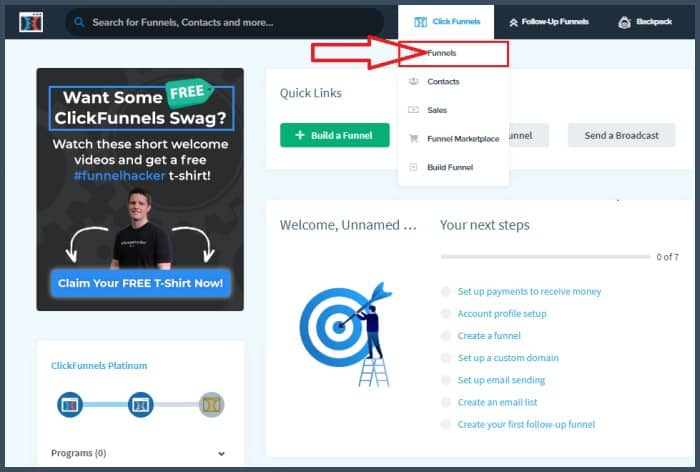
Step #2: Choose Funnel Type
Next, you need to choose a funnel type for your website. The primary determinant of the funnel type is the purpose of your website.
You can choose from the following funnel types:
- Lead Capture Funnel: Helps generate leads and build an email list. The goal is to get sign-ups for a freebie or newsletter for their contact information.
- Sales Funnel: You can use it to sell products or services. The goal is to get visitors to make a purchase.
- Membership Funnel: Helps you to create a paid membership site. Its primary objective is to get sign-ups for a paid subscription.
- Event Funnel: Do you want to promote and sell tickets to an event? The event funnel is the best option.
- Homepage Funnel: The homepage funnel is a perfect match if you want to drive traffic to a specific page on your website. It helps visitors take a particular action on the page, such as making a purchase or signing up for a freebie.
There are more funnels that you can use to build a website. In our case, we will go with the homepage funnel because it’s not specific to any one type of website.
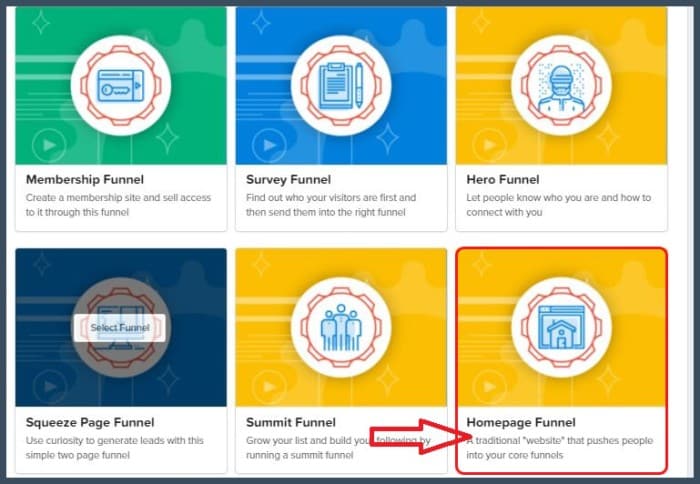
Step #3: Choose a Homepage Template
After selecting the homepage funnel, it’s time to choose a template. ClickFunnels has a wide range of templates that you can use for your website.
The templates are categorized by industry as well as the website type. For example, if you’re creating a website for a restaurant, there are templates for that industry.
You can always customize them later, but it’s handy to start off with a good base.
If you want to create a custom design for your website, you can also do that with ClickFunnels.
The tool allows you to select a blank page and add/arrange elements according to your needs.
There are paid and free templates on the ClickFunnels platform. If you’re new, it’s a good idea to start with the free option.
You can always upgrade to a paid template later on if you want to.
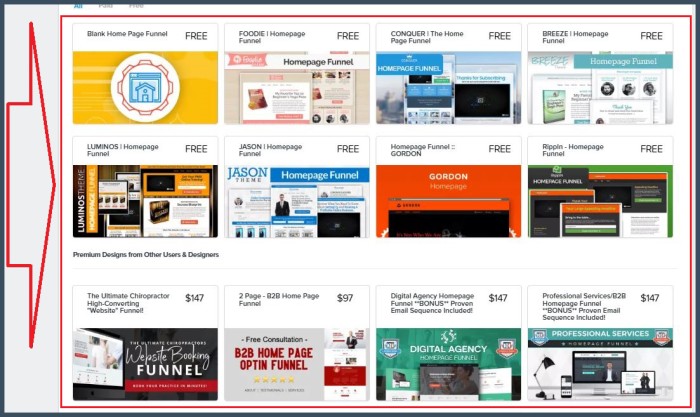
Step #4: Add a Domain
You can link your homepage funnel to a custom domain or subdomain.
If you don’t have a domain, you can buy one through ClickFunnels. The cost of a custom domain is $20 per year.
To add a custom domain, go to the “Accounts Settings” option, located on the top right, where you have your profile picture.
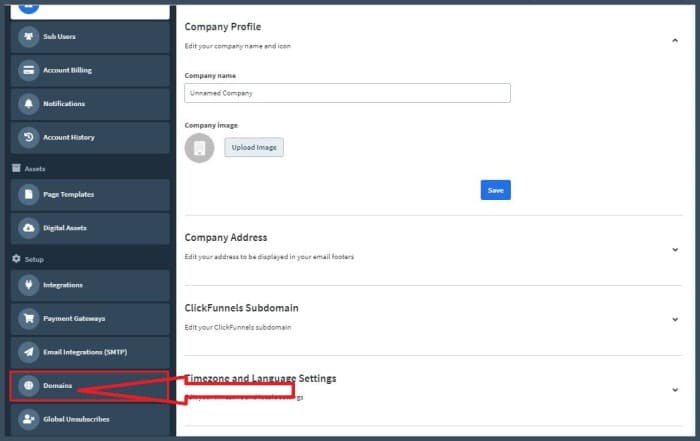
After that, you can click on the “Domains” tab and add a domain or buy one. In addition, you can create a subdomain on ClickFunnels.
A subdomain is a URL attached to the main domain, but it functions as a separate website.
For example, if your primary domain is “example.com,” your subdomain could be “blog.example.com.”
It would be treated as a different website even though it has the same root domain.
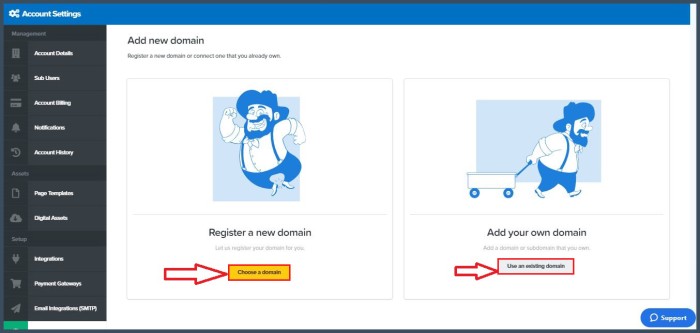
Step #5: Link the Domain and Page
After adding a domain, go back to your funnel and click on the “Settings” option.
You will be redirected to a page where you can add your domain. Insert the URL of your domain or subdomain and click on the “Save and Update Settings” button.
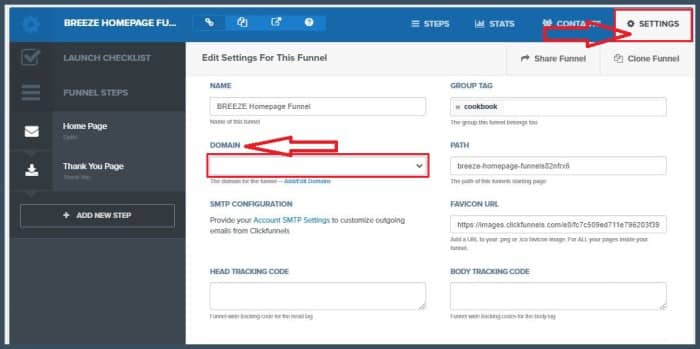
Step #6: Customize Your Page
Now, it’s time to add content and customize your page. You should rename your page to match your website’s structure.
ClickFunnels allows you to drag and drop elements on the page to create a custom design.
You can add text blocks, images, videos, buttons, opt-in forms, etc. If you want to get more creative with your designs, you can use the HTML editor.
ClickFunnels also allows you to add more pages beyond what the template comes with.
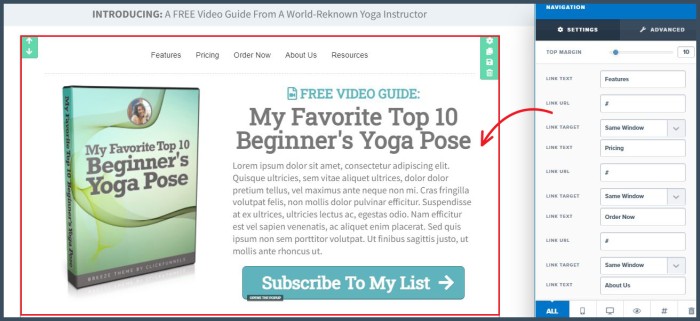
Step #7: Add More Pages
Unlike traditional websites, ClickFunnels uses a page-based structure. If a user clicks the link at the top of your page, they’re taken to a different page section.
But maybe you want a more conventional website. How do you create the pages?
You can design different funnels that represent pages of your website. To create a new page:
- Open your funnel page.
- On the bottom left part, click “Add Step.”
- Add the funnel name and the path.
- Then, click “Create Funnel Step.”
- After that, add a template to the step.
Just like you did with the homepage, customize each page to fit your goals.
Unfortunately, a series of loose pages can lead to a disjointed website experience.
You’ll want to add a navigation menu at the top of your site for a better user experience. Here is how you should go about it:
- At the top of your homepage, add a column with different sections. You can have an “About Us,” “Services,” “Contact Us” page, etc.
- Interlink each section with the relevant page you created. For example, if someone clicks on the “About Us” section, they should be taken to the About Us page.
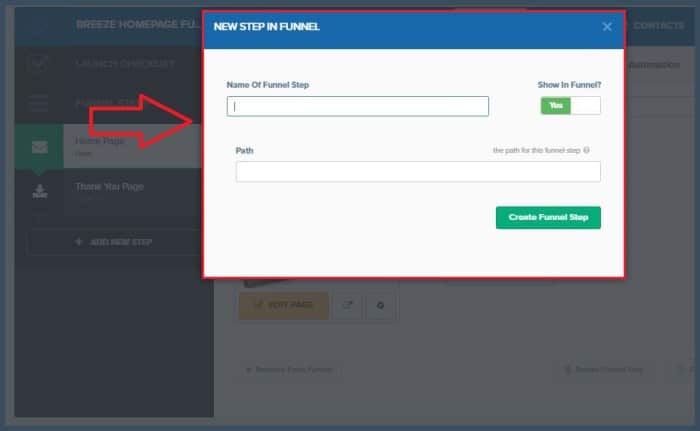
Step #8: Preview and Publish Your Website
When you’re happy with your website, it’s time to preview and publish it. Go to the “Launch Checklist” option located on the top left of your screen.
After that, click the “Visit URL” icon to get a preview of the website. You will see how your website looks on desktop and mobile devices.
If you want to make changes, you can go back and edit the pages. When satisfied with your website, click on the “Publish” button.
Your website will go live, and people will see it online. That’s it! You’ve successfully created a website using ClickFunnels.
The entire process is simple and doesn’t require any coding skills. Anyone can create a website with ClickFunnels.
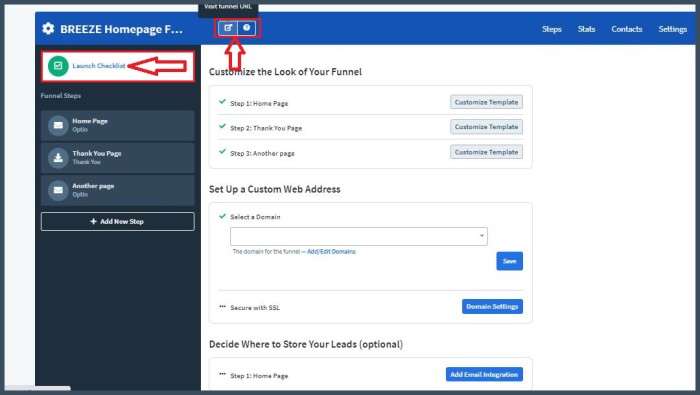
ClickFunnels Website Templates
If you want to create a website with ClickFunnels, you can choose from various templates.
There are templates for different types of businesses, such as coaching, consulting, e-commerce stores, etc.
You can also find templates for specific pages that might be included in a funnel. These include page templates for a homepage, sales page, webinar page, etc.
The trick is to find templates that are close to your vision and then customize them to perfectly fit your needs.
Then you just need to interlink the pages to create a cohesive website. You can also purchase ready-made ClickFunnels website templates.
These are pre-designed websites that you can customize to fit your business.
However, if you go through the steps above, you can create a website for free without purchasing a template.
ClickFunnels Website Examples
Unless you see a real-life ClickFunnels website, it’s hard to imagine what one looks like.
Here are some examples of websites created with ClickFunnels. Pay attention to some of the features that were used!
1. Foundr
The moment one sets eyes on the Foundr homepage, it’s a feast for the senses. The colors, images, and CTA buttons are vibrant and eye-catching.
But how do you know if the website was designed with ClickFunnels?
A quick search on the company’s search area for the term “ClickFunnels” will show you the different pages that were used to design the website.
Apart from the homepage, there’s also a landing page for their online course. You can easily tell that the landing page is a product of ClickFunnels.
But what features did the creators use to design such a beautiful website?
- Opt-in form templates: To get people to sign up for their online course, Foundr uses an opt-in form template. This allows them to collect leads and build their email list.
- Drag and drop editor: The drag and drop editor is used to create the different sections of their website.
- Email follow-up sequences: Foundr uses email follow-up sequences to nurture their leads and get them to purchase their online course.
- Webinar funnels: They have a webinar funnel to promote their online course.
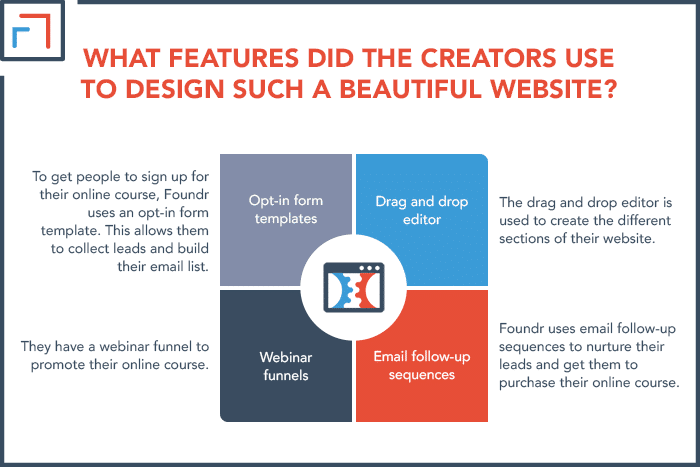
2. AppSumo
The company’s website is another great example of how you can use ClickFunnels to create an e-commerce store.
AppSumo allows you to add items to your cart and check out without leaving the website. This is made possible by the Order Form and Checkout Page templates.
The company also uses email follow-up sequences to upsell products and services.
The website uses a checkout page template, an order form template, and email follow-up sequences.
By looking at these two examples, it’s evident that ClickFunnels can be used to create any website.
All you need is a vision and a suitable template, and you can create a beautiful website in no time.
ClickFunnels vs. Website
Now that we’ve seen what ClickFunnels can do, let’s compare it to a traditional website.
| Point Of Difference | ClickFunnels Website | Traditional Website |
|---|---|---|
| Pages | Easily customizable | Complex to customize |
| Design | No need for design skills | Requires design skills |
| E-commerce | Templates available | Needs integrations |
| Pricing | Higher long-term cost | High initial cost |
| SEO Compatibility | Considerably compatible | Highly compatible |
| Free Trial | Available | No free trial |
| Templates | Available & customizable | Available but complex |
| Integrations | Easy to add integrations | Complex process |
| Mobile Friendliness | Good | Good |
| Speed | Higher speed | High but can be improved |
1. Pages
A website has different pages, such as the homepage, about page, contact page, etc.
A ClickFunnels website also has different pages called “funnels.” A funnel is a series of interlinked pages designed to take the user from point A to point B.
For example, the “Product Launch” funnel is designed to take a lead from subscribing to your email list to buying your product.
2. Design
You can use ClickFunnels to create a website without hiring a web designer. However, if you want more control over the design of your website, you can use WordPress.
With WordPress, you can choose from thousands of themes and plugins to customize your website.
The downside of WordPress is that it’s a bit more complicated to use compared to ClickFunnels.
3. E-commerce
If you want to sell products on your website, ClickFunnels has built-in templates that you can use. You can also use WordPress to create an e-commerce store.
However, you’ll need to install a plugin (such as WooCommerce) to add e-commerce functionality to your website.
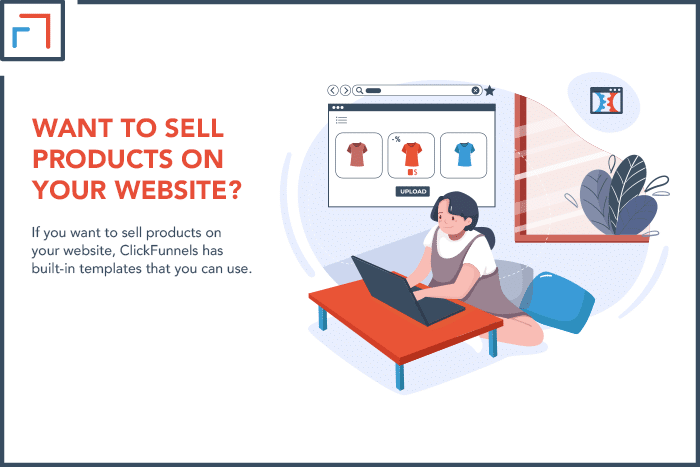
4. Pricing
A traditional website is usually cheaper to set up than a ClickFunnels website.
A ClickFunnels membership will cost either $97 or $297 per month (depending on your subscription plan). Other website services will cost some money, but are generally cheaper to use.
Some are even free! However, ClickFunnels is preferable if you want to make money from your website.
The tool has built-in features that you can use to make money from your website. You have to spend money to make money after all!
5. SEO Compatibility
A ClickFunnels website is not as SEO-friendly as a WordPress one. This is because WordPress websites are designed with search engine optimization in mind.
However, you can still use ClickFunnels to create a website that ranks well in the search engines. You need to use the right keywords and write compelling copy.
You can also use WordPress plugins (such as Yoast SEO) to help you optimize your website for search engines.
6. Free Trial
ClickFunnels offers a 14-day free trial. You can use this time to test out the tool’s different features and see if it’s right for you.
If you decide that ClickFunnels is not for you, you can cancel your account before the trial period ends, and you won’t be charged anything.
On the other hand, a conventional website builder does not usually offer a free trial. Therefore, you’ll need to pay for hosting and a domain name upfront.
7. Templates
ClickFunnels comes with a wide range of templates that you can use to create your website.
These templates are designed for different purposes, such as lead generation, sales pages, webinars, etc.
WordPress also has a wide range of themes and plugins that you can use to customize your website. However, the selection is not as good as ClickFunnels.
8. Integrations
ClickFunnels integrates with several third-party tools, such as email providers, payment processors, CRMs, etc.
This allows you to add more functionality to your website and automate your business.
WordPress also integrates with a wide range of third-party tools. However, the integration is not as seamless as ClickFunnels.
9. Mobile Friendliness
This is a tie. Both ClickFunnels and WordPress websites are mobile-friendly.
You can design a ClickFunnels website to be responsive or create a separate mobile version of your website.
With WordPress, you can choose from thousands of themes and plugins designed to be mobile-friendly.
10. Speed
A ClickFunnels website is generally faster than a WordPress website.
However, the loading speed is dependent on the elements that you add to your website, such as images, videos, etc.
ClickFunnels uses less code and fewer plugins. However, you can still use WordPress caching plugins, such as WP Rocket, to speed up your website.
Conclusion
Can you build a website with ClickFunnels? Yes, you can. However, it’s important to understand the pros and cons of using ClickFunnels before deciding if it’s right for you.
If you’re looking for an all-in-one solution that is easy to use and comes with everything you need to build a website, then ClickFunnels is a good option.
However, if you’re looking for more control over the design of your website and want to use a tool that is more SEO-friendly, then WordPress is sometimes a better option.
